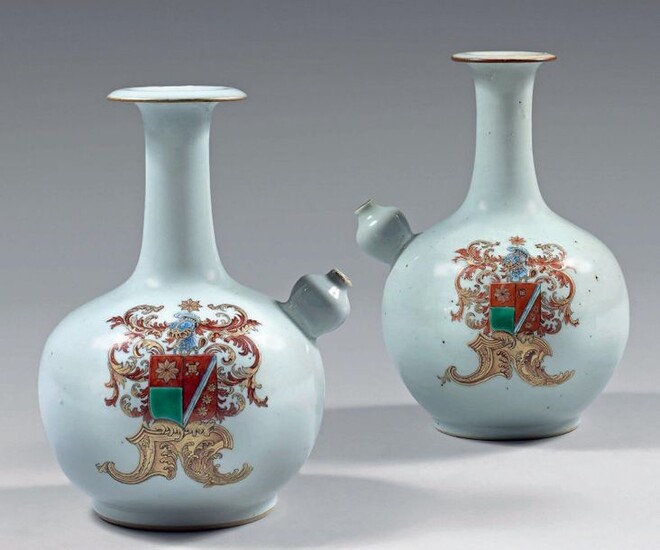Two Chinese porcelain "kendi". 18th century, circa 1749-63.
Two Chinese porcelain "kendi". 18th century, circa 1749-63.
Globular in shape, with a high neck and rounded spout, decorated on each side with enamels of the Rose Family, large coat of arms surmounted by a helmet and on a rocaille console, gold fillet on the rim, one with small restorations, small stripes.
H: 23,5 cm
Provenance:
The coat of arms is that of the Heere family of Middelburg, the Netherlands.
This family, originally from the Rotterdam area, had painters among its members, but above all a Governor of Ceylon for the VOC in 1697, as well as other members who were part of the VOC at the beginning of the 18th century.
The adjoining coats of arms are those of Jan de Heere and his wife (unidentified), married in 1704. However, given the date of production, it would seem more plausible that these two kendi, which are part of a group of pieces with the same decoration, were produced for Huijbert Johan de Heere (1731-1777) who had left the Netherlands for the VOC in Batavia; he married Jacoba Frederica Nemegheer in Sumatra in 1758 and returned to the Netherlands in 1763, probably with all these armorial bearings.
For a large dish, see by Thomas V. Litzenburg and Ann T. Bailey, Chinese Export Porcelain in the Reeves Center
Collection at Washington and Lee University, 2003, p. 114, no. 102. Automatically translated by DeepL. To see the original version, click here.
View it on
Estimate
Time, Location
Auction House
Two Chinese porcelain "kendi". 18th century, circa 1749-63.
Globular in shape, with a high neck and rounded spout, decorated on each side with enamels of the Rose Family, large coat of arms surmounted by a helmet and on a rocaille console, gold fillet on the rim, one with small restorations, small stripes.
H: 23,5 cm
Provenance:
The coat of arms is that of the Heere family of Middelburg, the Netherlands.
This family, originally from the Rotterdam area, had painters among its members, but above all a Governor of Ceylon for the VOC in 1697, as well as other members who were part of the VOC at the beginning of the 18th century.
The adjoining coats of arms are those of Jan de Heere and his wife (unidentified), married in 1704. However, given the date of production, it would seem more plausible that these two kendi, which are part of a group of pieces with the same decoration, were produced for Huijbert Johan de Heere (1731-1777) who had left the Netherlands for the VOC in Batavia; he married Jacoba Frederica Nemegheer in Sumatra in 1758 and returned to the Netherlands in 1763, probably with all these armorial bearings.
For a large dish, see by Thomas V. Litzenburg and Ann T. Bailey, Chinese Export Porcelain in the Reeves Center
Collection at Washington and Lee University, 2003, p. 114, no. 102. Automatically translated by DeepL. To see the original version, click here.



